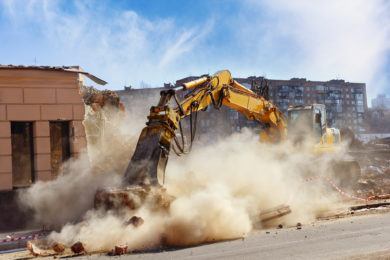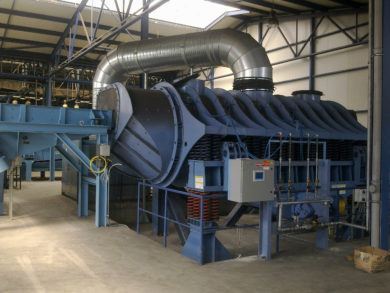We all know crystalline silica, a mineral that is commonly found in construction materials like concrete and mortar, is commonly associated with a wide variety of work-related health issues, such as silicosis (i.e., lung fibrosis explicitly caused by the inhalation of silica dust), chronic renal disease, lung cancer, pulmonary tuberculosis, and other diseases of the respiratory system. Therefore, the Occupational Safety and Health Administration (OSHA) has issued and updated a series of regulations to protect workers from silica exposure.
This article will provide background on silica exposure, discuss some of the main silica regulations, and explore how GK enclosed vibratory systems can help improve your production and ensure that silica regulations are met.
Crystalline Silica Exposure
Silica exposure can occur during a wide variety of construction, demolition, and manufacturing processes; especially those that involve grinding, transportation, or mixing dry silica-containing materials such as sand molds in ways that produce and disperse fine powders.
Compared with the silica found on sandy beaches, respirable crystalline silica produced during various industrial tasks consists of particles that are approximately one hundred times smaller, which makes these particles far easier to inhale as an airborne dust than standard sand. According to the Centers for Disease Control and Prevention (CDC), millions of workers are regularly exposed to crystalline silica in the United States.
Silica Regulations
Because of the risks and reach of crystalline silica exposure in the United States, OSHA has issued two silica standards—one for construction environments (effective June 23, 2017) and the other for general industry and maritime environments (effective June 23, 2018)—to help combat silica exposure and silica-related health issues. The primary goal of the new silica standards is to limit worker exposure to respirable crystalline silica through the implementation of permissible exposure limits (PEL) and other precautions.
Unlike the previous OSHA silica standard, which set the PEL based on the estimated silica exposure by using a formula that accounted for the type of silica present in an air sample, the new silica regulations is set at a simple numerical value of 50 μg/m3, with an action level of 25 μg/m3; which accounts for all silica types in aggregate.
The use of personal protective equipment (PPE), i.e., a respirator with an assigned protection factor of at least 10 (as specified by the OSHA standard), is determined according to the estimated silica exposure associated with a given task averaged over a standard eight-hour day. However, in addition to the use of PPE, OSHA suggests the use of alternative methods, such as sawing systems that apply water to the saw blade, to limit the amount of airborne silica produced during various dust-producing tasks.
In addition to the change in PEL estimation, the new standard also requires:
- the establishment and implementation of an exposure control plan that includes an outline of exposure protection methods and a description of access restrictions for high-exposure areas;
- the designation of an individual to oversee the implementation of the exposure control plan;
- the restriction of housekeeping methods that can aggravate airborne crystalline silica levels (e.g., dry sweeping) when safer alternatives are available;
- the medical examination of employees who are regularly required to use a respirator to perform their day-to-day tasks, as well as the maintaining of records related to both silica exposure and examination;
- and the training of employers on the effects of silica exposure and ways of limited exposure.
VIBRA-DRUM® Sand Casting Conditioner
At General Kinematics, our engineers have design solutions that automate your process and keep silica away from your operators. The VIBRA-DRUM® Sand Casting Conditioner, as well as the SPIRA-COOL® Casting Cooling Conveyor, and other enclosed GK systems are completely enclosed in order to keep silica dust out of the air and away from your employees, providing a safer work environment.
The VIBRA-DRUM® Sand Casting Conditioner effectively breaks down high-tonnages of sand while cleaning castings without introducing high levels of fine particles to the air, thus reducing the risk of silica exposure and related illnesses over that of open-air processes.
To find out more about the capabilities of GK enclosed vibratory equipment, contact our foundry and metalcasting experts at General Kinematics. We can help you design the right equipment for your process to ensure workplace safety and effective automation.








